Customers’ needs have changed in recent years, and traditional brick-and-mortar banking methods just won’t suffice — especially with millennial, who now number over 75 million. But banks and financial institutions are paying attention, and they’re embracing new technologies to compete in this digitized, data-driven, device-using world. By implementing artificial intelligence technology, banks would see costs cut dramatically, along with improved functionality and increased offerings. But that’s only the tip of the iceberg of AI’s benefits to the world of finance. With the ability to find, gather, and analyze large amounts of data instantaneously then decipher those findings with brain-like intelligence, AI can detect points of compromise as soon as they occur, which will help in fraud detection as well as prevent the theft of funds and personal information. Companies like MasterCard and WorldPay have been using AI to detect fraudulent transaction patterns for several years now.
By implementing artificial intelligence technology, banks would see costs cut dramatically, along with improved functionality and increased offerings. But that’s only the tip of the iceberg of AI’s benefits to the world of finance. With the ability to find, gather, and analyze large amounts of data instantaneously then decipher those findings with brain-like intelligence, AI can detect points of compromise as soon as they occur, which will help in fraud detection as well as prevent the theft of funds and personal information. Companies like MasterCard and WorldPay have been using AI to detect fraudulent transaction patterns for several years now.
Banks across the world, especially in Europe, have begun replacing older statistical-modeling approaches with artificial intelligence and cognitive computing technology. AI technology can even help with credit risk management by accurately predicting which customers are more likely to cancel service or default on their loans. Its data profiling analysis can determine if someone is of high or low risk by scouring through variables and values of relationships, co-factors, interactions, dependencies, associations, and more. AI even has the potential to pick winning stocks and investments by studying earnings statements, news reports, and regulatory filings in search of clues. With the automation of due diligence, anything is possible.
Digital banking is not an option; rather, it is a must-have strategy essential to surviving in a highly competitive environment. The strong growth in the digital banking has made it imperative for banks to transform their existing operations into an Omni-channel approach.
In other words, provide the same banking experience to customers irrespective of the channel – be it web, mobile or physical branch.
The development of a strategy towards achieving supremacy in digital banking must consider core elements in their entirety to achieve desired goals. The primary element is innovation – the ability of the bank to develop unique ideas to transform it. The next element is automating processes, systems and organizational design in order to provide a superior experience to the bank’s customers. Other facets such as mobility and big data must then aid these elements. Big data allows banks to take informed decisions by leveraging the capabilities of data analytics. Similarly, banks need to leverage mobility tools, web and social media platforms and other connectivity options to build even closer relationships with their customers.
Recent Trends in Banking: All Roads Lead to Digital
There are several trends making a strong impact on the digital banking space. Some of these trends are relatively mature, whereas a few recent developments still have fairly low penetration or usage among banks.
Mobile Banking
In emerging markets such as China and India, the penetration of mobile banking is stronger as compared to developed markets. Most banks today offer mobile banking, ranging from basic mobile applications to more sophisticated apps comprised of unique value added services and features – such as social media integration and augmented reality. Many new mobile-only banks have cropped up across the globe and are threatening the market share of traditional banks.
Social Media
New disruptive technologies are now being used by banks to integrate social media into banking services, ranging from payments, transfers to even utilizing it for calculating credit scores and lending decisions.
Biometrics
Banks are now increasingly using voice biometrics, fingerprint scanning and iris scans as authentication tools to enhance security platforms and address identity theft-related challenges. Biometrics is considered a serious contender to replace passwords in the future.
Cloud
The use of cloud to process banking transactions is expected to attain a 60% global market share by 2016. SAAS and cloud software offer huge advantages in terms of cost and scalability.
Bank CIOs’ can offer an enhanced customer experience by leveraging cloud computing tools and integrating cloud with their digital offerings.
Personal Finance Management
Personal financial management applications have evolved from basic tools to more advanced and automated platforms that leverage big
data, analytics, behavioral research and other technologies to automate and digitize personal financial management. Banks are offering these value-added services to enhance engagement levels with customers.
Contextual Banking
In today’s dynamic and hyper-connected business environment, it has become imperative for banks to o er the right service to the right customer at the right time. Omni-channel banking that provides a consistent banking experience to customers across multiple channels is becoming key to success.
Digital Wallet
Digital wallet is a mature digital banking technology, with strong usage and penetration among customers. Customers frequently use wallets to conduct small transactions across the globe. The market is expected to grow 30% on a CAGR basis in the next 5 years.
P2P Lending & Payments
P2P and other alternative digital lending platforms have garnered attention in the last several years, due to an increased volume of funding and owing to shorter turnaround times in loan disburse, innovative credit appraisal methods and improved lending rates.
Block chain
Block chain, or distributed ledger technology, is expected to transform the entire financial services space – be it back-end banking operations, trade finance and lending, payments or insurance. Banks around the world are either exploring usage of block chain or testing it in their operations.
Wearables
Wearables are being evaluated by banks as a new interaction and authentication medium. With increasing penetration among consumers, wearables are poised to become a mainstream digital banking application.
Disruptions & Innovations – What Does the Future of Banking Look Like?
New innovations and disruptions in the banking and financial services industry make the future look very exciting and technology focused. Block chain is already creating ripples in the banking technology space with a myriad of new applications being explored with the distributed ledger technology. Similarly, the wealth management space is being disrupted by ‘robot advisor’ platforms that are not only automating portfolio management, but also integrating innovative technologies.
Several new innovations are redefining the payment landscape, such as near field communications, biometrics and block chain.
Another notable disruption is branches are being transformed to create true Omni-channel banking experiences with new and innovative digital technologies – ranging from portable bank to video tellers and 100% digital or paperless branches.
Image-based banking that utilizes smart phone cameras to capture deposits, checks or bills is another disruptive technology making waves in the banking industry. Virtual agents, live chats and social media-based support channels are being offered by banks to provide an enhanced service experience to customers.
The internet-of-things, which has revolutionized many industries, is also making its presence felt in the banking space. Machine learning and artificial intelligence are also being explored to enhance the customer experience.
Many banks have set up their own innovation labs to explore new banking applications and disruptive technologies. They are also organizing hackathons and participating with fintech accelerators to explore new disruptive technologies. Banks are collaborating and establishing strategic alliances with fintech companies, as they do not want to
lag behind in the race towards innovation and disruption. Banks are making APIs open to third parties to scale up their ecosystem of strategic partners and speed development of disruptive applications. New banks such as Fidor and Atom have emerged as serious threats to traditional banks and thus it has become imperative for traditional banks to adopt new technologies through strategic alliances with fintech players.
BFSI IT Vendors & Consulting Companies – What Are They Doing to Remain in the Race?
IT companies such as UST Global, Infosys, Accenture and others are focusing strongly on disruptive banking technologies such as AI, machine learning and block chain, and making digital a strong priority across all financial services verticals. Consulting firms
such as McKinsey and Bain are also increasingly focusing on transforming the existing operations of their banking clients towards the digital ecosystem.
IT companies are organizing fintech hackathons and investing in startups that are coming up with novel technologies to disrupt the banking space.





